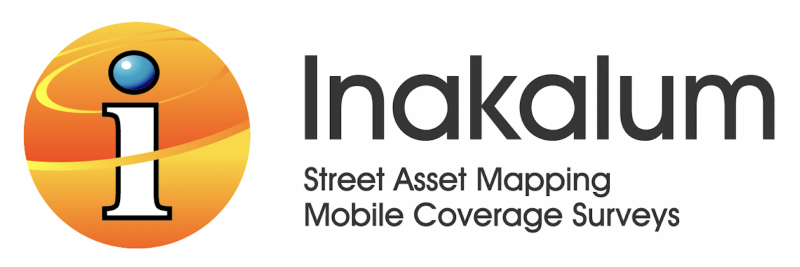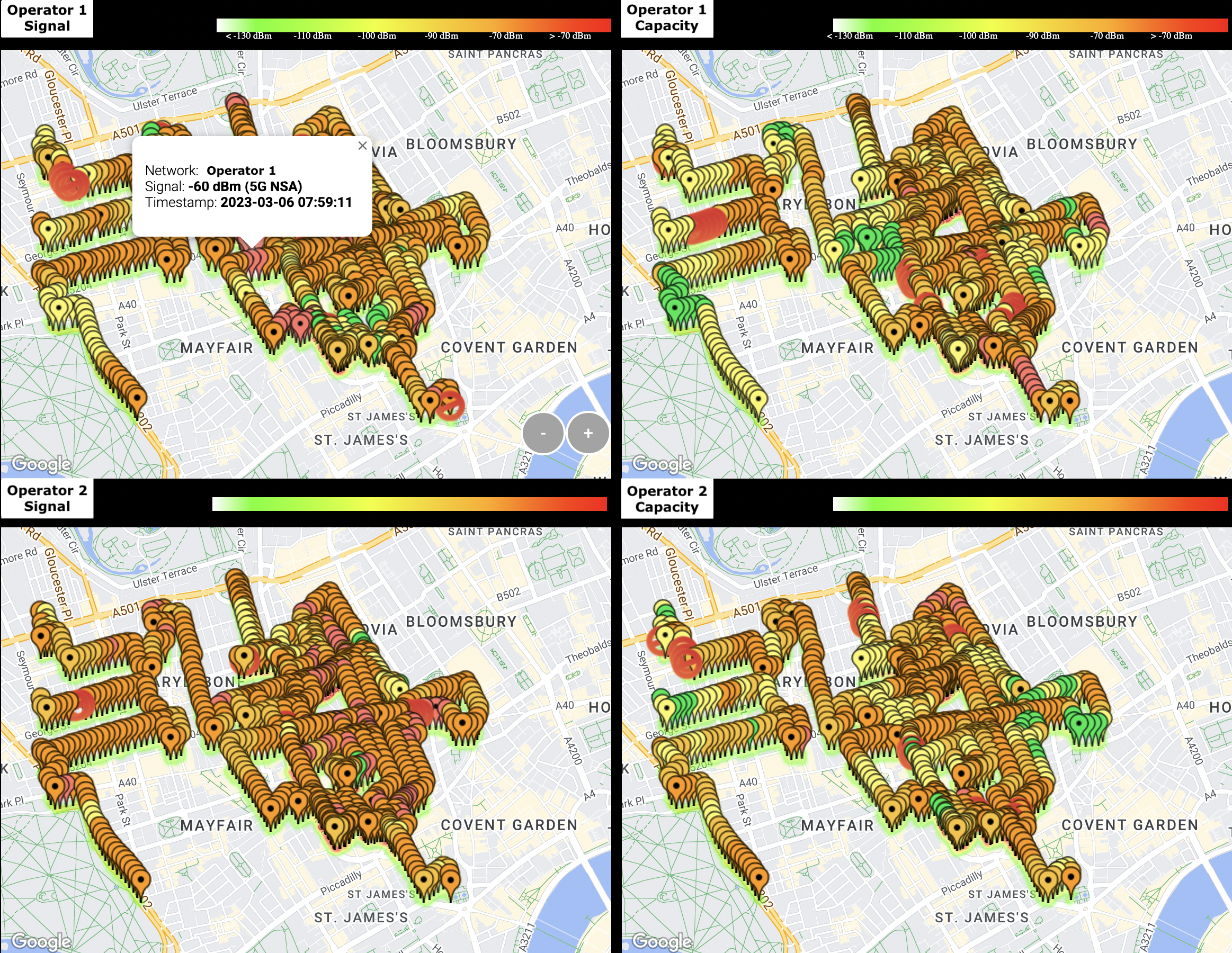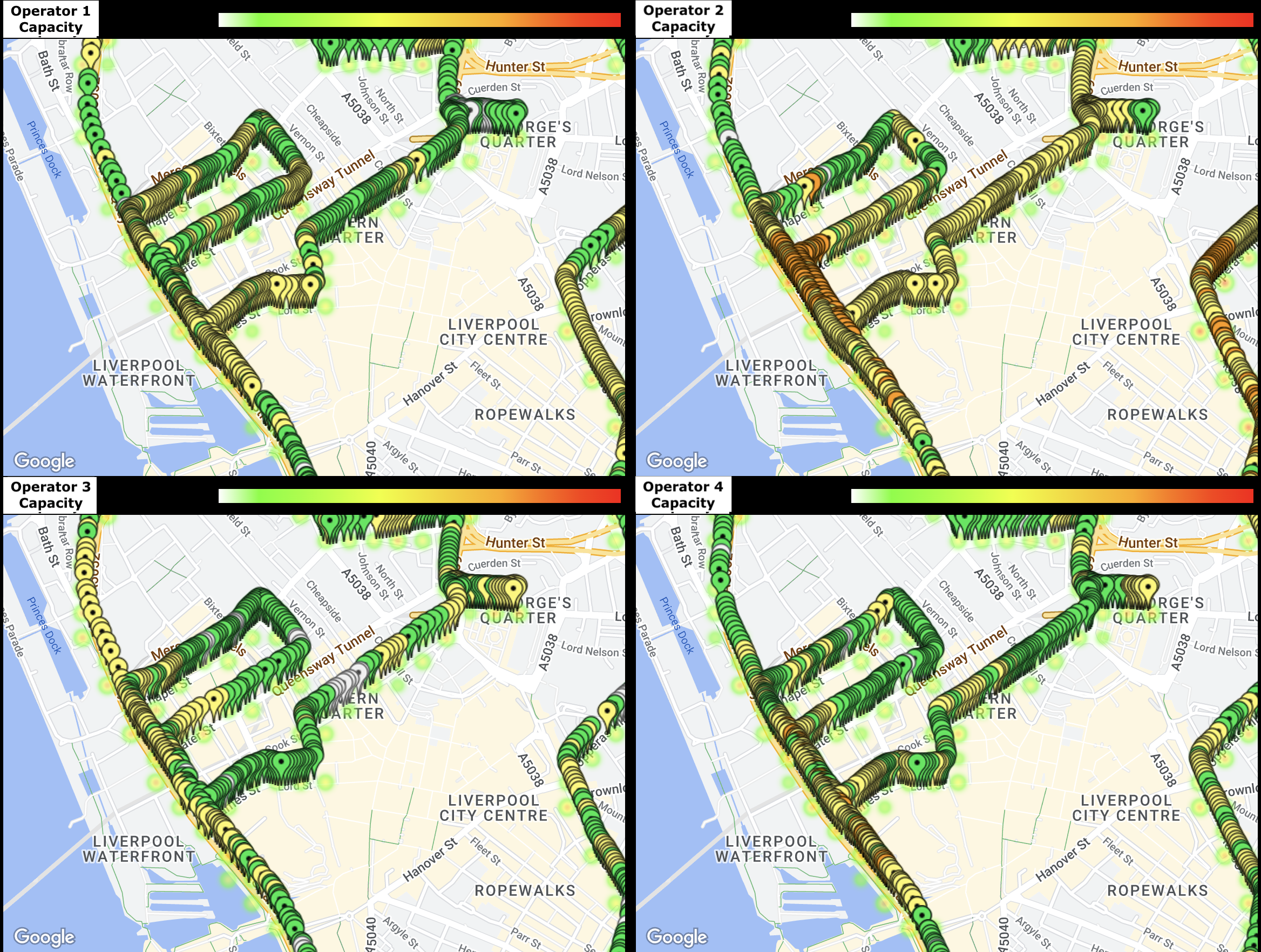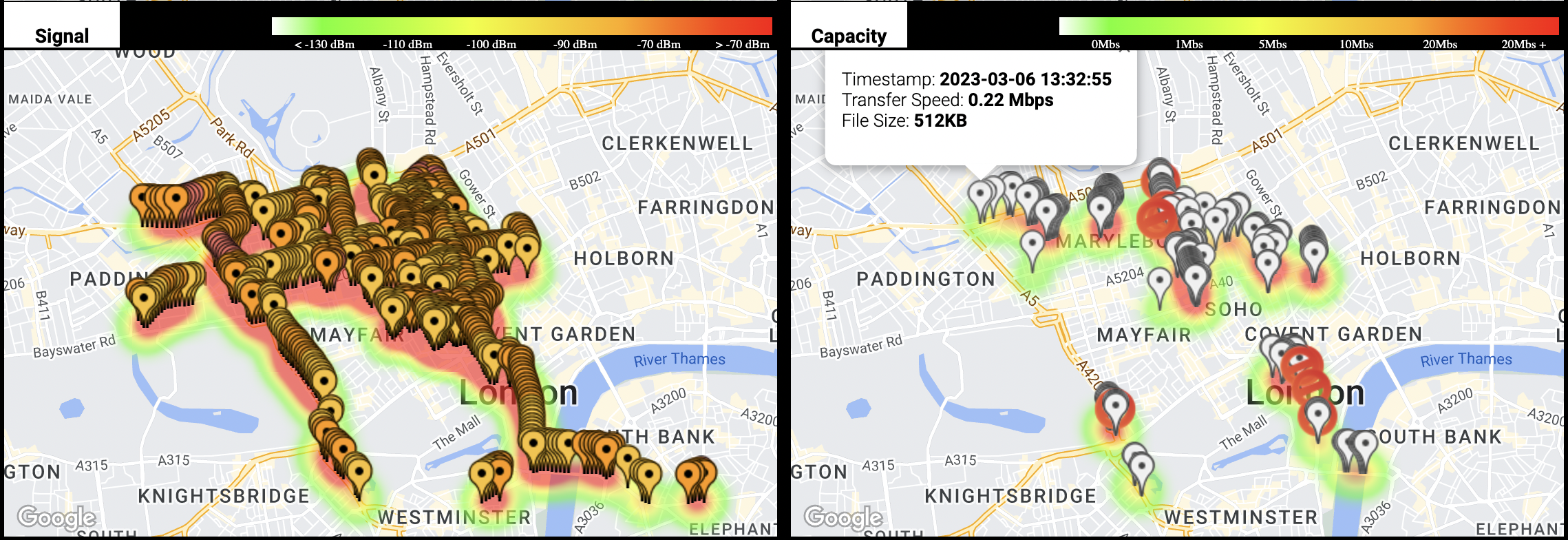Inakalum measures and maps both Signal Strength (dBm) and Capacity (upload/download speeds Mbps) of all main Mobile Network Operators (MNOs) simultaneously and under the same conditions, to give a true reflection of the coverage users can expect in the areas we survey.
Mobile Coverage Mapping (dBm)
We continually poll the cell towers of all networks as we drive/walk around an area and we record the strength of each operator’s signal (dBm), building a complete picture of the mobile coverage in an area. Our results are displayed in coverage maps which show the individual signal strength readings we logged as we surveyed, showing granular street-level data with each record timestamped to show when the data was recorded.
Map pins are colour-coded to indicate the strength of the signal at each point and the maps for all four main network operators can be shown side-by-side for easy comparison.
Mobile Capacity Mapping – Upload/Download Speeds (Mbps)
A good mobile signal is essential for good mobile coverage, but it is not the only factor in delivering ` good user experience. That’s why we also measure data transfer speeds (Mbps) by continually uploading and downloading files to our AWS-hosted server and measuring the data transfer speeds as we survey.
Map pins are colour-coded to indicate the upload/download speeds at each point and the maps for all four main network operators can be shown side-by-side for easy comparison.
Not Spots – Find Them Easily
From a user’s perspective, a not spot may not be an area that does not have a signal. It’s very common to have 3 or 4 bars of 4G, or even 5G, coverage in an area but you still can’t load a web page on your mobile device. A good user experience needs both signal coverage and capacity, i.e. upload and download speeds that allow you to do whatever it is you want to do on your phone, whether it’s web browsing, video calling, streaming or uploading videos to/from social media platforms.
By using the filters in Inakalum’s mobile coverage web service, it’s easy to show good signal coverage on one map, whilst showing poor capacity (< 1 Mbps) on an adjacent map. Such areas may not be deemed as not spots by network operators or Ofcom, but the user trying to get service in the area may disagree.
Why Survey The Mobile Service?
We get asked a lot why it’s important for local authorities to have good data on the mobile coverage and performance in their areas. It’s true that councils are not responsible for the mobile service, but they have great sway with mobile operators when it comes to improving the service. More and more, operators are relying on councils to provide access to public infrastructure for hosting mobile equipment such as small cells. Also, many of the services being delivered by local authorities, such as paid parking, are migrating to online solutions which need mobile data service to function.
The performance of individual mobile networks changes over time as they get busier and data usage increases, so regular mobile coverage and performance surveys can highlight trends in network performance, helping to identify and mitigate against data performance problems before they arise.
Here are some examples below of the importance of mobile service to local authorities, and why it’s important for councils to have reliable mobile coverage and performance data readily available.
Capacity Issues
How many times have you seen 2, 3 or even 4 bars of coverage on your mobile device, but your apps just won’t load? That’s usually because of lack of network capacity to deal with the traffic the network is trying to handle. These ‘not spots’ are not easily identifiable as the mobile operators usually only report on coverage, and not performance. Inakalum’s surveys include capacity tests which are achieved by constantly uploading and downloading files to our cloud server and calculating the data throughput rates. Inakalum’s map-based query tool allows you to set filters so you can easily find areas which have good signal coverage, but poor data performance. Overall, users only value data performance and areas with capacity issues deliver a poor user experience, despite having good signal strength.
Meaningful Discussions With Mobile Operators
The relationship between local authorities and mobile network operators can be difficult at times, as they both have very different agendas. On the one hand, the operators want to invest in service improvements where they can get the best ROI, but councils are charged with providing the best service they can for the people who live, work and play in their area. The trade-off comes when operators want to locate mobile equipment on public infrastructure in a particular area, while the council would like to see service improvements in another area. This discussion happens often between the parties, but without credible data to back up the council’s claims that the mobile user experience is poor in certain areas, even though the coverage is good, it’s hard to convince operators to invest in improving the service in those areas. Inakalum’s performance data (upload/download speeds Mbps) provides councils with the data they need to back up their claims and the operators cannot deny that certain areas are delivering a poor user experience because of capacity or other issues.
Home Monitoring Systems
Many councils provide vulnerable residents with home monitoring systems for care and/or security. These systems often rely on the mobile network to operate so it is important for the council to know whether or not there is good signal coverage and capacity for the intended mobile operator in a location, before a home monitoring kit is installed.
Smart Infrastructure
The service delivery model is evolving for councils as new technology gets deployed. For example, smart litter bins can be monitored remotely and send a notification to a control centre when they need to be emptied. Smart infrastructure such as this relies on the mobile network to relay information, so it’s important for councils to know which mobile operators provide adequate service in an area before smart infrastructure is deployed.
IoT Sensors
IoT sensors are popping up all over urban areas and they can provide valuable information such as air quality, weather, footfall, traffic, flooding. Most IoT sensors rely on the mobile network to relay their data, so knowing which operators provide adequate service in an area is important before deploying sensors.
EV Charge Points
EV Charge Points will be part of life from here on and there’s a huge proliferation of charge points expected in the coming years to meet demand, as electric vehicles gain popularity. Public EV charge points usually rely on the mobile network to relay their data, so knowing which operators provide adequate service in an area is important before deploying charge points.
CCTV Surveillance Systems
Public CCTV cameras use the mobile network for relaying data, so it’s important to know which mobile operators provide adequate service in target areas, before deploying cameras.
Paid Parking Apps
The days of on-street parking meters are limited and they will soon be replaced by parking apps. Before this migration can be considered, it’s important to know that there is good coverage and capacity for all the main mobile operators in target areas, to ensure that all motorists will be able to use their apps to pay for parking.
Digital Signage
Many councils are now using digital signage in public areas as they offer the flexibility of delivering content remotely over the mobile network. Councils can also monetise public assets by making leasing access to them for digital advertising. SIM-enabled digital signage relies on mobile data service to deliver content to signs, so it’s important to know which mobile operators can provide adequate data service when considering locations for new digital signage.
Tourism
Councils work hard to make sure that they provide the best possible experience for visitors to their areas. Travellers use apps for booking accommodation, travel, restaurants, shows, attractions, etc. They also want to share their experiences with friends and family on social media, so it’s important that they can use their mobile devices for data when they’re out and about. A poor mobile user experience reflects badly on a town or city and, even though local authorities do not provide the mobile service, visitors expect the councils to use their influence with the mobile operators to ensure that the mobile service is good in their areas.
Shared Mobility Services
e-bikes, e-scooters and on-street club cars which can rented for short periods are becoming essential mobility services in busy urban areas. These services are generally activated using mobile apps, so it is essential that there is good mobile coverage and performance for all the main mobile operators where the bays for these shared mobility services are located. As the councils are generally responsible for locating these bays, it’s important to know what the mobile coverage is like in an area before establishing a bay there.







